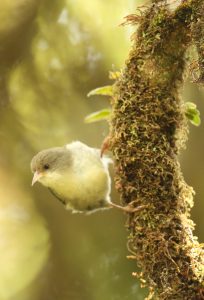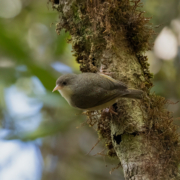Mosquito Control Project to Save Honeycreepers Underway on Maui and Kaua‘i – Method Aims to Prevent Hawaiian Honeycreeper Extinctions
Several Hawaiian honeycreepers are facing imminent extinction due to avian malaria carried by invasive southern house mosquitoes. Members of the multi-agency partnership Birds, Not Mosquitoes (BNM) have begun releasing non-biting male southern house mosquitoes on Maui and Kaua‘i to reduce their populations. Following years of rigorous study and analysis, the releases began in November 2023 after regulatory approval from state and federal agencies.
“This really is a critical milestone as it demonstrates the strength of our partnerships to ensure the long-term survival of our island’s honeycreepers,” says Dr. Earl Campbell, U.S. Fish and Wildlife Service Field Supervisor for the Pacific Islands Fish and Wildlife Office. “It is made even more momentous as our collaborative efforts occur during Makahiki o Nā Manu Nahele, the Year of the Forest Bird.”
This work is part of the U.S. Department of Interior’s Strategy to Prevent the Extinction of Hawaiian Forest Birds and it is urgent: Hawaiʻi’s forest birds have declined from more than 50 different native honeycreepers to just 17 species remaining today.
“Manu are revered as our ‘ohana and for too long, their songs have been declining,” says Ulalia Woodside Lee, Executive Director, The Nature Conservancy Hawai‘i and Palmyra. “We have a kuleana, a responsibility, to give nā manu nahele a chance to nourish Hawaiian culture and spirit, as well as pollinate our forests and keep them growing. We are looking forward to the day when honeycreepers aren’t rare in Hawaiʻi’s forests.”
Mosquitoes are rapidly moving to higher elevations as the climate changes and native forests get warmer and drier. Without significantly reducing mosquito populations, multiple native bird species are likely to go extinct in the wild in less than 10 years, including the kiwikiu and ʻākohekohe on Maui, and ʻakikiki and ʻakekeʻe on Kauaʻi.
The male southern house mosquitoes, which do not bite or transmit disease, carry a strain of the common, naturally occurring Wolbachia bacteria. When they mate with females in the wild, which carry a different strain of this bacteria, their eggs don’t hatch, causing the mosquito population to decrease. No new species are being introduced to Hawai‘i; both the mosquitoes and the Wolbachia bacteria are already here. This method has been safely used to control the spread of human diseases by mosquitoes around the world.
“This project is our best opportunity to reverse the trend of shrinking bird populations for these species that are found only in Hawaiʻi,” says Dr. Lindsey Nietmann, Forest Bird Recovery Coordinator for the Hawai‘i Department of Land and Natural Resources Division of Forestry and Wildlife. “In addition to protecting the birds that remain in our forests, we hope these efforts will one day lead to the release of captive populations that are currently in conservation breeding facilities and awaiting re-introduction to the wild.”
Monitoring is an essential part of this project. It helps determine if mosquito populations are decreasing, malaria prevalence is decreasing, and native bird populations are stabilizing or increasing. Maui Forest Bird Recovery Project (MFBRP) has been leading implementation on Maui. Landscape level deployment has begun over a few thousand acres of remote forests on East Maui.
“Our monitoring is driven by science and is designed to gather the best possible data,” says Dr. Christa Seidl, MFBRP’s Mosquito Research and Control Coordinator. “Our field team provides essential boots on the ground and in the air, spending long, often wet days in remote forests checking mosquito traps and collecting data.”
Kaua‘i Forest Bird Recovery Project has been leading efforts on Kaua‘i, and has completed small scale pilot releases to assess how far the male mosquitoes travel. Next steps include releases over a few thousand acres of forest on the Alaka‘i Plateau.
This project could not have happened without substantial state and federal partnership and funding. In particular, the Biden administration’s Investing in America Agenda committed nearly $16 million through the Department of the Interior to catalyze extinction prevention in Hawai‘i. This funding is part of the broader Hawaiian Forest Bird Conservation Keystone initiative. The National Fish and Wildlife Foundation is also a major supporter.
“This effort represents the culmination of decades of collaborative research between the Department of the Interior and State biologists, non-governmental organizations, and private enterprises,” says Dr. Dennis LaPointe, Research Ecologist at United States Geological Survey Pacific Island Ecosystems Research Center. “The timely development of this safe and effective tool to suppress mosquito populations in forest bird habitats brings new hope for the preservation of the remaining Hawaiian honeycreepers.”
In 2024, the partnership will continue releases on Maui, expand releases on Kaua‘i, and prepare a Statewide Environmental Assessment. The State Department of Health will lead that assessment, which will address application of this method for both conservation and public health.
###
American Bird Conservancy is a nonprofit organization dedicated to conserving wild birds and their habitats throughout the Americas. With an emphasis on achieving results and working in partnership, we take on the greatest problems facing birds today, innovating and building on rapid advancements in science to halt extinctions, protect habitats, eliminate threats, and build capacity for bird conservation.
The Nature Conservancy, Hawai‘i and Palmyra: The Nature Conservancy is a global non-profit organization dedicated to conserving the lands and waters on which all life depends. Informed by science and guided by traditional values and practices, we apply innovative, nature-based solutions to our world’s toughest challenges so that nature and people can thrive. TNC has forged partnerships to manage 14 preserves and other sites in Hawai‘i and Palmyra Atoll, working with government, private parties and communities to protect Hawai‘i’s and Palmyra’s forests and coral reefs for their ecological value and for the many benefits they provide to people.
The U.S. Fish and Wildlife Service works with others to conserve, protect, and enhance fish, wildlife, plants, and their habitats for the continuing benefit of the American people. The Service works closely with partners to conserve fish, wildlife, plants, and their habitats throughout Pacific Islands. The areas we help to protect include the state of Hawaiʻi, the Territory of Guam, the Territory of American Samoa, the Commonwealth of the Northern Mariana Islands, and the islands and waters located within Papahānaumokuākea Marine National Monument, Rose Atoll Marine National Monument, and the Pacific Remote Islands Marine National Monument.
Maui Forest Bird Recovery Project (MFBRP): MFBRP is a project of the Pacific Cooperative Studies Unit (PCSU) of the University of Hawaiʻi at Mānoa in association with Hawai‘i Department of Land and Natural Resources (DLNR), Division of Forestry and Wildlife (DOFAW). It is funded and supported by numerous partners including the U.S. Fish and Wildlife Service and Nā Koa Manu Conservation Inc. MFBRP is driven by science and dedicated to the conservation of Hawaiʻi’s native forest ecosystems. Our mission is to develop and implement techniques that recover Mauiʻs endangered birds and to restore their habitats through research, development, and application of conservation techniques.
Kauaʻi Forest Bird Recovery Project (KFBRP): KFBRP is a project of the Pacific Cooperative Studies Unit (PCSU) of the University of Hawaiʻi at Mānoa in association with Hawai‘i Department of Land and Natural Resources (DLNR), Division of Forestry and Wildlife (DOFAW). It is funded and supported by numerous partners including the U.S. Fish and Wildlife Service, DOFAW, and several other organizations and individuals. The Kaua‘i Forest Bird Recovery Project is committed to promoting knowledge, appreciation, and conservation of Kaua‘i’s native forest birds, all of which are unique to Hawai‘i; several are endemic to (found only on) Kaua‘i.
Pacific Cooperative Studies Unit (PCSU): PCSU’s mission is to protect and restore Hawai‘i’s native species, ecosystems, and cultural resources.



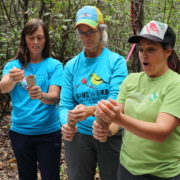
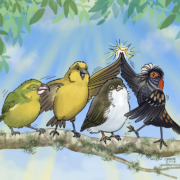
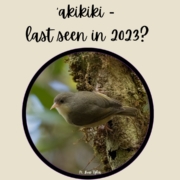
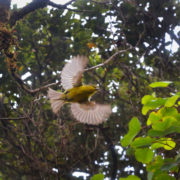
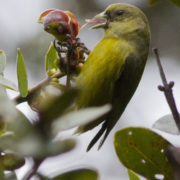
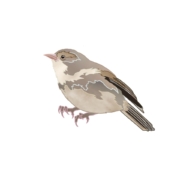
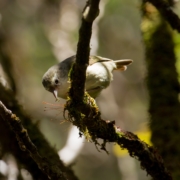 Robby Kohley
Robby Kohley
